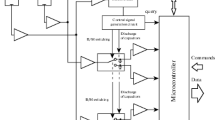Abstract
The concept of the System for the Observation of Daytime Asteroids (SODA system) has been developed, the purpose of which is to detect at least 95% of hazardous celestial bodies larger than 10 m in size that fly towards Earth from the Sun side. Spacecraft, equipped with the optimum version, which has three wide-angle optical telescopes of small aperture (20–30 cm) will be placed in a halo orbit around the L1 libration point of the Sun–Earth system. This will provide a warning on the hazardous object, approaching from the Sun side, and will allow one to determine the orbit and the point of body entering Earth atmosphere to a sufficient accuracy, at least a few hours before the body collides with Earth. The requirements to the system are considered, the results of a preliminary design of the set of instruments have been described, the areas of visibility are calculated, and the versions of data transmission modes have been proposed. It has been shown that, in cooperation with other (particularly ground-based) projects aimed to observing objects flying from the night sky side, it is possible to detect in advance all hazardous bodies in the near-Earth space larger than 10 m in size that approach Earth from almost any direction.
Similar content being viewed by others
References
Defending Planet Earth: Near-Earth-Object Surveys and Hazard Mitigation Strategies, Washington, DC: The National Academies Press, 2010.
Perna, M.A. and Barucci, M.A., and Fulchignoni, M., The near-Earth objects and their potential threat to our planet, Astron. Astrophys. Rev., 2013, vol. 21, no. 1, id 65.
Shustov, B.M., Naroenkov, S.A., Emel’yanenko, V.V., and Shugarov, A.S., Astronomical aspects of building a system for detecting and monitoring hazardous space objects, Sol. Syst. Res., 2013, vol. 47, no. 4, pp. 288–295.
Asteroidno-kometnaya opasnost: strategiya protivodeistviya (The Asteroid–Comet Hazard: A Mitigation Strategy), Puchkov, V.A., Ed., Moscow: FGBU VNII GOChS (FTs), 2015.
Shustov, B.M., Shugarov, A.S., Naroenkov, S.A., and Prokhorov M.E., Astronomical aspects of cosmic threats: new problems and approaches to asteroid—comet hazard following the Chelyabinsk event of February 15, 2013, Astron. Rep., 2015, vol. 59, no. 10, pp. 983–996.
Shustov, B.M., A modern approach to revealing hazardous celestial bodies, Kinematika Fiz. Nebesnykh Tel, 2016, vol. 32, no. 5, pp. 11–17.
Micheli, M., Koschny, D., Drolshagen, G., Perozzi, E., and Borgia, B., NEO follow-up, recovery and precovery campaigns at the ESA NEO Coordination Centre, Proc. Int. Astron. Union, 2016, vol. 10, no. S318, pp. 274–281.
Shustov, B.M., Naroenkov, S.A., and Efremova, E.V., On population of hazardous celestial bodies in the near-Earth space, Sol. Syst. Res., 2017, vol. 51, no. 1, pp. 38–43.
Dunham, D.W., Reitsema, H.J., Lu, E., Arentz, R., Linfield, R., Chapman, C., Farquhar, R., Ledkov, A.A., Eismont, N.A., and Chumachenko E., A concept for providing warning of Earth impacts by small asteroids, Sol. Syst. Res., 2013, vol. 47, no. 4, pp. 315–324.
Jeong, S, Ahmad, S., Barrillon, P., et al., The slewing mirror telescope of the Ultra Fast Flash Observatory Pathfinder, Proc. SPIE, 2012, vol. 8443, id 84432S.
Wen, W.-B., Wang, F., Li, C.-L., et al., Data preprocessing and preliminary results of the Moon-based Ultraviolet Telescope on the CE-3 lander, Res. Astron. Astrophys., 2014, vol. 14, no. 12, pp. 1674–1681.
Rozhavskii, E.I. and Moiseev, P.P., Precision optomechanical scanning devices of the MSU-GS remote sensing system, Mekh. Upr. Inf., 2009, no. 1, pp. 503–509.
Burt, J. and Smith, B., Deep Space Climate Observatory: The DSCOVR mission, in IEEE Aerospace Conference Proceedings, 2012.
Il’in, I.S. and Tuchin, A.G., Quasiperiodic orbits in the neighborhood of the libration point L1 of the Sun–Earth system, Preprint of the Institute of Applied mathematics, Russ. Acad. Sci., Moscow, 2016. http:/library. keldysh.ru/preprints.
Naroenkov, S.A., Shustov, B.M., and Emel’yanenko, V.V., On the arc length of observations of a small solar system body sufficient to classify it as hazardous, Cosmic Res., 2013, vol. 51, no. 5, pp. 335–341.
Heinze, A., Tonry, J.L., Denneau, L., et al., ATLAS: Forecasting falling rocks, in American Astronomical Society. DPS Meeting no. 48, 2016, id 405.04.
Author information
Authors and Affiliations
Corresponding author
Additional information
Original Russian Text © A.S. Shugarov, B.M. Shustov, S.A. Naroenkov, M.A. Zvereva, 2018, published in Kosmicheskie Issledovaniya, 2018, Vol. 56, No. 4.
Rights and permissions
About this article
Cite this article
Shugarov, A.S., Shustov, B.M., Naroenkov, S.A. et al. Space System for Detecting Hazardous Celestial Bodies Approaching Earth from the Daytime Sky (SODA). Cosmic Res 56, 283–292 (2018). https://doi.org/10.1134/S0010952518040056
Received:
Published:
Issue Date:
DOI: https://doi.org/10.1134/S0010952518040056




